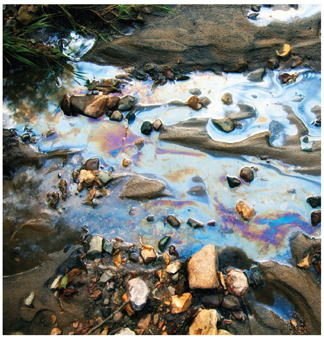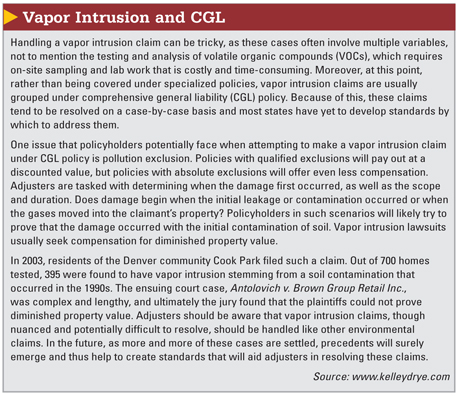 The tiny pinhole in the pipe elbow probably took more than20 years to form and cause a leak, a day or two to be discovered,and less than an hour to be repaired. This recent claim involvingthe corrosion of a pipe elbow on a home heating oil tank resultedin the minor release of a few gallons of heating oil into the surrounding surface soil. The insured actedappropriately, and the release was quickly investigated andrepaired. Based on the size of the tank and the volume of therelease, state regulations did not apply; however, local regulatorsquickly became concerned about the potential impact to shallowgroundwater in the area.
The tiny pinhole in the pipe elbow probably took more than20 years to form and cause a leak, a day or two to be discovered,and less than an hour to be repaired. This recent claim involvingthe corrosion of a pipe elbow on a home heating oil tank resultedin the minor release of a few gallons of heating oil into the surrounding surface soil. The insured actedappropriately, and the release was quickly investigated andrepaired. Based on the size of the tank and the volume of therelease, state regulations did not apply; however, local regulatorsquickly became concerned about the potential impact to shallowgroundwater in the area.
Although the shallow aquifer was not considered a source ofdrinking water, it was used extensively for irrigation purposes.Furthermore, the property owner soon noticed petroleum-like odorsinside the home and office, necessitating relocation for a coupleof days. A few weeks after the repair of the leak, the situationwas completely resolved with the excavation and removal of impactedsoil from beneath a patio and a portion of the building adjoiningthe point of release. Fortunately, specialists were able to notonly discover but also remedy the release quickly. Moreover, thevolume of the spill was not sufficient to impact groundwater, whichcould have easily transported contaminants and associated vaporswell beyond the boundaries of the insured's property.
|This type of loss is a fairly typical example of a residential environmental claim. Years ago, this claim may havebeen settled simply as a mechanical issue, with much less focus onthe longer-term environmental considerations, regulatory impact,and vapor intrusion into the home. Recently, the complicatingfactors to these claims have been growing. Therefore, the methodsemployed to handle environmental cases continue to progress. By thenature of this type of work, environmental issues frequently evolvebecause of the regulatory climate, technological advances,litigation, and cost considerations.
|Four Trends to Consider
|To address these changes, insurers enlist the expertise offorensic consultants in crafting these strategies:
- Crossover services. As noted in theaforementioned project, often claims that begin as standardforensic engineering investigations routinely incorporate anenvironmental component, such as soil and groundwater hazards, andindoor air quality issues, along with asbestos and moldconcerns.
- Cost-reduction strategies. Not surprisingly,there has been an increased focus on controlling expenditures. Theinsurer's handling of the claim, the role of forensic consultants,and leveraging of technology are all areas subject to cost-controlmeasures.
- Application of technology. New technology is not only used to reduce expenses, but is alsocrucial in expediting claim resolution while improving the qualityof an investigation and the speed of delivering information.
- Third-party claims. Innovative developments inthe energy production sector and previously dismissed issues in theenvironmental cleanup industry have resurfaced and have producedthird party claim concerns that were previously uncommon. Theseinclude vapor intrusion into occupied buildings from volatilechemicals associated with new and historical releases impactingsoil and groundwater, and pollution concerns regarding the use ofhydraulic fracturing techniques in the production of domesticnatural gas.
Under the Microscope
|Over the past several years, specialized consulting services anddiagnostic testing equipment have become imperative in thedisposition of forensic engineering and fire claims. Unforeseen consequences of accidents, failures,and oversights often include impacts to the environment as well ashuman health. Forensic engineering firms are well aware of theseissues and their changing complexities. Firms typically developmultidisciplinary teams of environmental consultants to supportcases. These teams may include environmental scientists,geologists, microbiologists, chemists, building scientists, andindoor air quality specialists. Team members are trained to workalongside the forensic engineers and fire investigators to providediverse consulting services, such as historical document reviews,desktop soil and groundwater evaluations, regulatory reviews,indoor air quality testing, and water penetration testing, as wellas determinations regarding asbestos and lead-based paint. Whilesupplemental services are not required on every project, each ofthese services can play a vital role in defining and understandingthe risks associated with a given claim, as well as the value of anappropriate remedy. Perhaps the most effectiveapplication of both traditional and multidisciplinary supportresources working together is as a follow-up to emergency response.After an emergency is abated and emotions are calm, a rational andcohesive approach to addressing both the cause of the emergency andthe most cost-effective, practical course of action for both theinsurer and the insured may be developed. For example, theimmediate goal of the fire fighter's response to a small kitchenfire is to save lives, extinguish the fire, and ensure that itstays out. Incidental water infiltration into other adjacent areasof the building is a collateral issue that will result in fungalgrowth within 24 to 48 hours, spurring its own set of concerns.
|Building materials containing asbestos along with volatile and semi-volatile organics andparticulates associated with incomplete combustion may also remain,posing a real or perceived threat to occupants during the cleanupand restoration phase. While this may appear to be a fire lossrequiring origin and cause investigation, the insurer would clearlybe best served by having access to a multidisciplinary team ofexperienced engineering and environmental consultants working onits behalf to fully define, understand, and address risks in anappropriate and defensible manner.
|Minimizing Expenditures
|There are many strategies currently employed to lower the costof claims processing. One primary strategy for insurers has been touse a clearinghouse approach to handle environmental claims byfunneling them through environmental centers. These centers arestaffed with adjusters possessing specialized environmentalexperience and knowledge. As mentioned above, consulting firmsoften form varied teams and appoint a single representative to meetthe specific needs of the case on behalf of the insurer. Forensicconsulting services may range from a routine desktop review by asingle consultant to a comprehensive third-party review andextensive data verification involving several individuals. Thesepractices should help better define and evaluate the risks,correctly focus the investigation, and reduce the amount of time spent dealing with the issueoverall.
|Often, a brief desktop review of readily available informationsupplied by the engineer or claims adjuster can help insurersunderstand the risks and evaluate the appropriateness of a remedyat a reasonable cost. As an example, let's consider this scenario:Following emergency response activities addressing the release of 100gallons of diesel fuel from an aboveground storage tank at a remoteconstruction site, the remediation contractor excavated 25 yards ofimpacted soil. The soil samples that were obtained and tested fromthe excavation indicated that elevated concentrations of dieselwere still present at depths of 1 to 2 feet. Consequently, thecontractor proposed additional limited excavation in the impactedareas with subsequent retesting.
|In this case, a desktop review of the available sitephotographs; testing data; regulatory cleanup levels; and localsoil profile, topography, and geology—in addition to telephoneinterviews with the on-site contractor and regulatoryauthority—would likely yield ample information to evaluate thecontractor's recommendation and supply the insurer with adequateoversight affordably. Of course, even this simple scenario hasseveral variables and cannot be universally applied. The type andquantity of material released, local soil, and groundwater conditions; the absence or presence of nearbysensitive receptors; concurrent health and safety issues; localenvironmental regulations; or the likelihood of litigation couldwarrant another approach and greater consultant involvement.
|
Time-Saving Technologies
|It should be noted that the use of time-saving technologies,such as ground-penetrating radar, infrared thermography,high-resolution aerial photography, and wireless access to remotedatabases and other information can provide answers quickly,especially when used in conjunction with short form reports andWeb-based report delivery methods. For example, water intrusionevaluations can be expedited with the assistance of an infraredcamera. A trained operator can therefore quickly (and relatively easily)identify areas of moisture, a determination that would havetraditionally required detailed and time-consuming moisture mappingtechniques and even destructive testing.
|In less than half of the time, however, areas of moisture can beimaged, mapped, and confirmed with moisture-specific measurements.Select infrared cameras are capable of receiving data from moisturemeters and other field devices via Bluetooth. Moisture measurementscan then be sent to the infrared camera for inclusion on theirrespective thermal images. This information can be processed into ausable report, and often delivered the same day using a mobiledevice with WiFi.
|Unwelcome Intruders
|Third-party claims and environmental issues go hand-in-hand. Twodeveloping areas of potential exposure to third-party claims arevapor intrusion in buildings and hydraulic fracturing in naturalgas production. Gaseous emissions of volatile chemicals fromcontaminated soil and groundwater can migrate into overlyingbuildings. These vapor emissions tend to move towards areas oflower chemical concentrations by diffusion and lower pressures byadvection. Pressures inside buildings are influenced by changes inatmospheric pressure, wind flowing over and around the building,internal and external temperature changes, and building ventilationequipment. These differences in pressure within a building drawvapors inside through basement or foundation cracks and other areasof possible penetration, creating a potential health hazard tooccupants. Although soil and groundwater pollution cases wereregarded as a minor environmental concern for years, regulatoryagencies throughout the country have now reopened closed cases tore-evaluate them for current on and off-site risks associated withvapor intrusion.
|While some believe that the risks are often exaggerated, thethreat of serious health concerns to occupants is now consideredvery real. Further, the perception of risk can be a powerful force.As a result, vapor intrusion is now fertile ground for lawsuitsinvolving those parties responsible for both new and historicalcontamination, commercial building owners, constructioncontractors, and others.
|In the late 1940s, hydraulic fracturing was first used toenhance gas production in rock formations. Recently, techniqueshave changed drastically and created an exploration “boom” in theNortheast and in areas of Texas. Using this process, a company maydrill a well that is several thousand feet deep and then turnhorizontally through a shale formation for a great distance.Drillers pump millions of gallons of water under high pressure tofracture the shale and release trapped gas.
|One key concern is the fact that the water is mixed with sandand chemicals, some known carcinogens, which could impactsurrounding property and water supplies. In addition, theinfiltration/migration of natural gas into drinking water is alsobeing investigated. The impacts on adjacent property and watersupplies are currently being evaluated, and litigation is forcingmore transparency and innovation in the process. The success inproduction and the extent to which the method is used will continueto increase claims activity and will evolve greatly over the nextseveral years.
|A Changing Landscape
|The need for environmental consulting services requiringspecialized training and consulting expertise has steadilyincreased in response to regulatory changes, public awareness, andlitigation. As an outgrowth of traditional forensicinvestigations, environmental issues often arise and typicallyrequire quick, cost-effective resolution. The strategic use ofmultidisciplinary teams and the application of technologies thatenhance reporting quality and speed are imperative.
|Public awareness of environmental issues continues to grow,increasing the likelihood of third-party claims. Forensicengineering firms are responding to these trends by expanding theirenvironmental capabilities to immediately define current andemerging risks so insurers can in turn handle these claimsappropriately on behalf of their policyholders.
Want to continue reading?
Become a Free PropertyCasualty360 Digital Reader
Your access to unlimited PropertyCasualty360 content isn’t changing.
Once you are an ALM digital member, you’ll receive:
- All PropertyCasualty360.com news coverage, best practices, and in-depth analysis.
- Educational webcasts, resources from industry leaders, and informative newsletters.
- Other award-winning websites including BenefitsPRO.com and ThinkAdvisor.com.
Already have an account? Sign In
© 2024 ALM Global, LLC, All Rights Reserved. Request academic re-use from www.copyright.com. All other uses, submit a request to [email protected]. For more information visit Asset & Logo Licensing.








